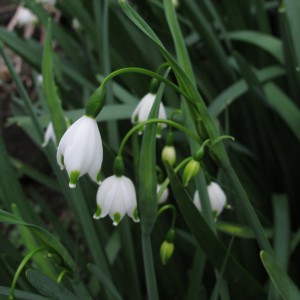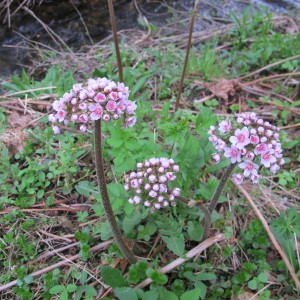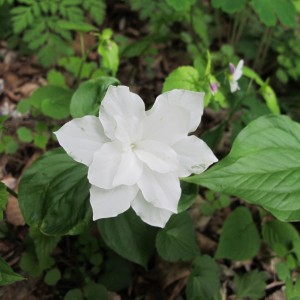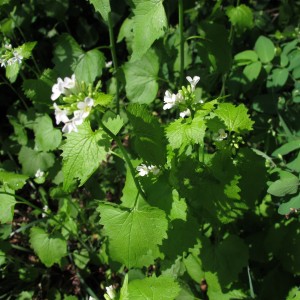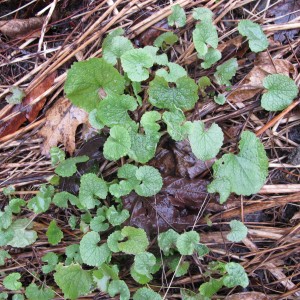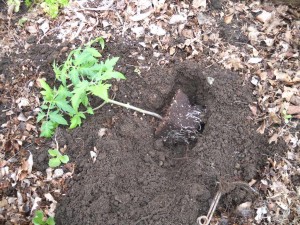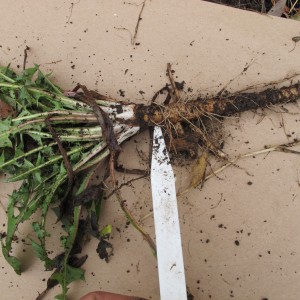Spring Flowers
Each year I anticipate spring with great enthusiasm not because I don’t like winter – which I do – but because almost every day there are new flowers blooming in my garden. I’m keeping a list as they bloom this year, and so far, near the end of May, I have almost 50 species and countless varieties that either have bloomed, or are blooming in my garden.
First to bloom each spring are the small bulb plants: snowdrops, winter aconite, scilla and glory of the snow. Then come the daffodils and tulips – many of which are still blooming nicely. My late tulips are still in bud.
This year I have some lovely grape hyacinths (Muscari spp.) including one called ‘Christmas Pearl” that I got from Brent and Becky’s bulbs last fall. I especially like it because each little bulb seems to send up 2 blossom stems, one large blossom and then a second smaller blossom a while later.
Now I have spring snowflake (Leucojum vernum) in bloom.Or maybe it is summer snowflake (L. aestivum). They both look a bit like snowdrops on steroids. The white blossoms look down like snowdrops, but are atop 16 inch stems, and have little green decorations at the tip of each petal. This is a bulb plant that I got as a gift over 20 years ago and the clump just gets a little bigger every year. It’s supposed to be a zone 5 plant, and I have had colder winters by far, but it keeps coming back. It’s in full sun with lightly moist soil.
Trillium is technically a wildflower, but I have 4 kinds that bloom for me in shade gardens. The common one is called wake-robin or stinking Benjamin (Trillium erectum). Like all trilliums, it has 3 leaves and 3 petals. The flowers are a deep maroon. Then there is the white-flowered one (Trillium grandiflorum) which generally blooms for a longer time than the common one, and often fades to pink. I also have a double white, which is very rare, and has extra petals. Lastly I have a yellow trillium (Trillium lutea) that I bought at the New England Wild Flower Society’s garden in Framingham, MA. Its native home is in the southern Appalachians, and is less hardy than the others. I have seen painted trillium (T. undulatum) in the woods. It is a native here, but I don’t have any. If I see one for sale, I will surely buy it.
Right now down by my stream is a favorite, a dramatic big-leafed plant, the umbrella plant (Darmera peltata). I planted it over some of the ashes I was given after my sister, Ruth Anne, died in 2009. The flowers are big clusters of small pink flowers that stand two feet above the ground. This year I have 9 stems, each topped with a cluster or cyme, 3 to 6 inches across. Later, the 2-foot wide leaves will grow big enough to serve as umbrellas for gnomes. I placed a marble bench next to these flowers – a good place to reflect on the ephemeral nature of life, while listening to the burble of the stream.
Under my wild apple trees I have what I call my primrose garden. It is dominated by candelabra primroses (Primula japonica) but has several other species as well. The “japonicas” as I call them, have 3 tiers of flowers that blossom in sequence, each a whorl of color- from magenta to pink to white. They throw seeds and spread like crazy for me. I have hundreds. They are in dappled shade and a fairly wet, rich soil.
Also in that primrose garden are some with no common name, though I call them “kissing primroses” because the Latin name, Primula kisoana, sounds a little like kiss (I pronounce it Kiss-O-Anna). These are low-growing and spreading primroses that are a deep pink, and are in bloom now. They spread by root, but do not overpower nearby plants, which is nice. There is a white one, which is less vigorous. Everyone should have the kissing primrose. I got mine from Cider Hill Gardens in Windsor, VT.
Also in bloom now is bleeding heart (Dicentra spectabalis). Listed in most books as needing full sun, I recommend just morning sun or dappled shade. In full sun the foliage dies back by mid-summer, while less sun allows it to look good until fall. It likes good, rich soil and some moisture, but I also have them growing out of a sheer rock wall where there is little or no soil at all. Go figure.
There is also a pure white variety (D. spectabalis alba), and pink and white varieties of its cousin, the fringed or wild bleeding heart (D. exemia). The fringed bleeding heart is a native woodland plant, though not common in the woods. I have those in pink and white varieties. They tend to bloom off and on all summer, and will grow in dry shade.
So go enjoy the spring and keep on buying new things and trying them out. We deserve spring flowers after the winter we had!
Henry Homeyer is a gardening consultant and the author of 4 gardening books. His web site is www.Gardening-Guy.com.
Garlic Mustard
As a garden writer I get a lot of email from people warning me about pending catastrophes: blights, bugs, invasive plants. Some are accurate, some are not. In 2012 we were told that a disease kills Impatiens (a lovely annual flower for shade) would make growing it impossible – ever again. But last year it did fine for many gardeners. Late blight on tomatoes is predicted every year, but my tomatoes have only been affected once. But I recently learned some disturbing news about an invasive weed, garlic mustard (Alliaria petiolata), that we should all pay attention to.
Invasive plants generally out-compete our native plants because they grow anywhere, often putting out leaves earlier in the spring than our natives, and holding them longer in the fall. Some, like the Norway maple, have roots that suck up water and nutrients far from the mother plant. Others, like barberry or honeysuckle, shade out natives in the understory of the forest. But garlic mustard, a seemingly innocuous little weed with a root system that is not hard to pull, goes one step beyond the others: it produces a toxin that kills necessary root-coating fungi on our maples, oaks and beeches. Where it grows, some of our favorite trees are in danger.
You may know that mycorrhizal fungi are beneficial fungi that coat the fine root hairs of many trees and perennial plants. They get sugars from the green plants and, as payback, share minerals that the green plants need but can’t extract from the minerals in their natural state. The mycorrhizal fungi produce acids that dissolve minerals in the soil and make them into a form that is readily taken up by the green plants. It’s a perfect symbiotic relationship: you scratch my back, I’ll scratch yours.
Here’s the bad news: Garlic mustard kills mycorrhizal fungi by producing chemicals and releasing them into the soil. Maples, oaks and white ash are all trees that depend on mycorrhizal fungi to succeed. Not only that, garlic mustard inhibits the germination of seeds of many species of native plants, including many spring wildflowers. And it has no natural predators here in the United States where it has invaded from Europe. In Europe it has at least 69 insect predators. Garlic mustard produces chemicals that make it uninteresting as food to herbivores like deer, as well as to insect predators.
So what can we do? First, understand its life cycle and learn to identify it. Garlic mustard is a biennial, meaning that it has a 2-year life cycle. In the first year it produces a low rosette of rounded leaves. The second year it sends up 18- to 36-inch flower spikes with pointy, heart-shaped leaves with jagged edges. The small white flowers have 4 petals and bloom in clusters about an inch or more in diameter. One plant can produce about 4,000 seeds. And although about 70% of the seeds will germinate the next year, some will remain viable in the soil for up to 10 years. A Web site full of good information is http://www.invasivespeciesinfo.gov/plants/garlicmustard.shtml.
Garlic mustard leaves when crushed smell a bit like garlic. Not as strong, but it has a distinct odor. The Europeans that brought it here in the 1860’s often grew it as an herb or a garlic substitute, and I have tasted pesto made from the leaves. But since it produces cyanide at a level much higher than other plants, I choose not to consume it. I figure that if the deer won’t eat it, I won’t either.
Here’s the good news: pulling up garlic mustard is easy. It has a white tap root that comes right out if you give it a tug. It is not like many pest weeds – it doesn’t spread by roots that easily break off and start new plants. Goutweed, Japanese knotweed and witch grass all spread by root, but garlic mustard does not. After pulling it, place garlic mustard in the household trash, not the compost pile. Or if you must, seal it in black plastic bags and let it rot in the sun until full decomposed.
How can you help to prevent its spread? Pull it if you see it. Watch for first year plants – it sometimes arrives in hay used for erosion control – it will grow in full sun or full shade. A good close mowing of plants will help, though one report I read said that garlic mustard cut at 10 cm (roughly 4 inches) would survive 29% of the time.
Garlic mustard is blooming right now! So go look for it. Organize a neighborhood group for a “pulling party”. It behooves us all to look out for it, and to do our best to reduce its numbers and prevent its spread.
Henry Homeyer can be reached at henry.homeyer@comcast.net. He is the author of 4 gardening books and a children’s chapter book about a boy and a cougar. His website is www.Gardening-guy.com.
Tomatoes
This year I met a lifelong goal of growing an edible tomato in the house, though I have I have to admit that it was quite by accident. Last fall I dug up an avocado plant that had started itself in the compost pile. Mixed in with the soil were seeds that germinated, including a tomato, a pepper and of course, weeds. I let the tomato grow and harvested a ripe tomato on May 10.
The plant has been in a west facing window and, although I did provide some supplemental lighting, that was only for a month or so. I don’t know what kind of tomato it is, but the flavor was excellent – a combination of sweet and tangy.
A few words about “volunteer” tomatoes: I get some in my garden each year, but never let them develop because many are not particularly tasty. Most modern tomatoes are hybrids (Big Boy, Jet Star, Sun Gold are all hybrids). That means that someone figured out that specific crosses of the parents would produce a tomato with desirable characteristics. But seeds from these hybrids will not breed true. Seeds saved from a Big Boy will most likely revert to one of the parents of the fruit, which may not be especially nice. So as you clean up your garden this spring, I recommend that you yank the babies.
What we call heirloom tomatoes do breed true. Tomatoes, unless manipulated for growing seed, are self pollinating. Heirlooms such as Brandywine, Purple Cherokee and Ox Heart will produce seeds that you can save each year and get just what you had the generation before. Heirlooms are not often sold at the grocery store because they are often of irregular size and shape (hard to package) and don’t have the tough skins needed for shipping and handling. But they have amazing flavors.
I grow both heirlooms and hybrids each year – a total, usually of about 30 plants. So why do I grow hybrids if heirlooms are so wonderful to eat? The modern hybrids have been bred for disease resistance, which is important. There are a variety of fungal diseases that can kill the leaves – or even the entire plant, and old fashioned breeding programs have developed tomatoes that resist them.
The worst disease for tomatoes is late blight. If it hits your garden, your tomato plants may well turn into a soggy, blackened mess of inedible fruit and dead plants in just a few days. Late blight also affects potatoes, and was the cause of the Irish potato famine. One hybrid tomato , the Defiant F-1, which was developed by the plant breeders working for Johnny’s Selected Seeds, is listed as “highly resistant” to late blight with “intermediate resistance” to early blight, another pest. I’ve grown it and like it. It has nice medium sized fruit, good flavor, and matures early.
There is much talk about GMO labeling in Vermont right now – they just passed a law that will require processed foods to indicate if there are genetically modified ingredients. As far as I know, there are no GMO tomatoes or other garden vegetables on the market. One GMO tomato was developed in 1994, but the public objected and the market for them was nil.
This year I started my tomato seeds indoors on March 24, three weeks earlier than usual. I transplanted them into bigger pots in early May and they are growing like crazy. But the plants are getting huge, which is a problem: they are too big to fit on my plant stand. I’ve had to remove a shelf so the plants can continue to grow.
If you have long, leggy plants like mine, you’ll need to plant them sideways when the time comes. I will dig a hole for the root ball and then a trench for the long stem. I’ll pinch off all the lower leaves, then cover the root ball and the stem except for the very top cluster of leaves. I‘ll bend the tip of the stem up so that the leaf cluster is above ground level. The plant will straighten itself up in a few days. The long stem will turn into roots. Alternatively, you could plant the rootball deep, burying part of the stem.
Whether you grew your tomatoes from seeds or bought plants at the garden center, it is important to harden-off the plants before they go in the garden. That means introducing them to the sun’s powerful rays and the wind’s drying effects a little each day until the plants are ready to go out in full sun. Put them near the house on the north side so that they get just a few hours of morning sun, then gradually give them more sun. Just like a fair-skinned toddler, plants can burn if they get too much sun. Greenhouses provide a lot of protection. And bring them in on cold nights.
A soil thermometer is a useful item at this time of year. Cold, wet soil is not good for most plants, and tomatoes in particular. Sixty degrees is a good minimum soil temperature to attain before planting.
I don’t plant frost-sensitive plants until well after the last frost, though a few warm days always tempt me. But lettuce, peas and other frost hardy things are going in now. I’m ready for summer!
Henry’s Web site is www.Gardening-guy.com. Contact info is there, along with previous articles and information about his gardening books.
Lessons from an Asparagus Patch
On a recent cold, gray Sunday I was looking for a good project to do in my garden. I decided to clean up my asparagus bed and get rid of last summer’s dead stalks and those sneaky weeds that had avoided my lethal grip. I had planted a new asparagus patch in 2012, so this is the first year that I can harvest a few stalks – and I can’t wait. I want to give my asparagus every advantage.
First, some basic information about asparagus. It is a perennial vegetable that, well tended, can produce for 25 years or more. It often grows in the wild, especially along roadsides where it competes with grasses and weeds. But in the garden it’s a fussbudget and won’t do well unless kept well weeded. In the wild it is known to grow in marshy places, too, but domesticated asparagus prefers well drained soil – but not dry soil. And full sun is best.
Asparagus roots radiate out from the center of the plant, and can be quite near the surface. When weeding it’s important not to disturb the roots, and to recognize them and cover them up if you expose them. The roots are brown and can be the diameter of a pencil lead near the tips, to the diameter of a pencil itself near the center of the plant.
I use a CobraHead Weeder which I like a lot. It is a single-tined weeder that works like a curved steel finger. It allows me to get at weed roots without disturbing the asparagus roots. In my bed I had a fair number of dandelions. I pushed my weeder into the soil about 4 to 6 inches, and then dragged it toward me on one side of the dandelion and then on the other side. That loosened up the soil without breaking off its deep tap root which resembles a scrawny carrot.
Next I grabbed the dandelion below the crown and applied gentle upward pressure so that I would not snap off the root. As with most perennial weeds, a morsel of the root left in the ground will grow and start over again. Most every time I got the entire root system.
Grasses, particularly witch grass, can be a real problem in the garden, and I had a little in my asparagus patch, though not a lot. Witch grass spreads by rhizomes, or roots that extend laterally. I get under the grass with my curved tool, apply some pressure from below at the same time lifting from above. Gently, so as to avoid breaking the white roots. Then, as the grass comes out, I am able to see where the roots are going, and tease them out, loosening the soil with my CobraHead and lifting. I often got roots that were 18 inches long or more. The roots have nodules where more grass leaves grow, so if you break off a root at a nodule, the plant continues to grow.
The ground was still quite wet when I was weeding my asparagus patch, so I stayed out of the bed itself as stepping in it would compress the soil and might damage roots. I brought along a kneeling pad – a simple foam pad – that kept my knees dry and protected them from sharp rocks. Some gardeners like kneepads for that function, but I’ve never found them terribly comfortable.
I plan to add 3 to 4 inches of compost over my asparagus bed, but first I want any weed seeds or broken bits of root to send up their new growth. I will remove those weeds, and then apply compost and a layer of mulch. We need some warm sun to get the weeds growing.
For mulch I use wood chips that I get from a local arborist by the truckload. They are free and easy to spread. I’ll wait until the soil has dried out and the tender asparagus shoots are poking up. I leave a little ring around the location of each plant to make life easier for my asparagus.
I know a fellow who bought a nice house with a mature asparagus patch. He loved asparagus and delighted in his free daily dose of it. But he wouldn’t stop picking, despite my warnings. For a young patch, pick for a month. For a healthy mature patch, six weeks is good. But never pick for more than 8 weeks. Asparagus needs plenty of time to re-charge its batteries, if you will. The fronds are actually leaves, and they need time to produce the food necessary for the roots to thrive. But he kept on picking long past the 8 weeks, and the next year he barely got a crop.
One last thought: if you are buying asparagus roots to plant, pick a variety that produces all male plants. The ‘Jersey’ series is all male, but the ‘Martha Washington’ roots are not – they will produce seeds, which is a waste of energy, and will produce lots of babies that will crowd your mature plants.
Henry Homeyer can be reached at henry.homeyer@comcast.net. His Web site is www.Gardening-Guy.com. He is the author of 4 gardening books and Wobar and the Quest for the Magic Calumet, a children’s fantasy adventure.



